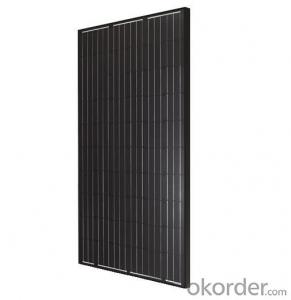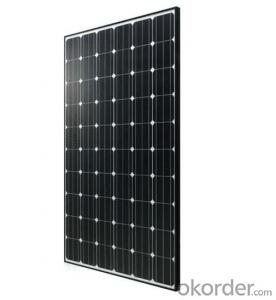mono panel SWE-M660 Series 250W
OKorder Service Pledge
OKorder Financial Service
You Might Also Like
SWE-M660-250/255/260/265/270
MONO CRYSTALLINE SOLAR MODULE
futures:
High module efficiency and stable power output base on leading process technology
Outstanding electrical performance under high-temperature or low-irradiance conditions
Ease of installation and applications due to the innovative engineering design
Rigorous quality control meets the highest internationalstandard
Added Value From Warranty
High module efficiency up to 16.60%
Positive power tolerance: 0/+5W
Robust frame to up to 5400Pa load
Self-cleaning surface
Anti-PID technology
Hot-Spot protect
Anti-Reflective glass
data sheet
| Electrical Characteristics @ STC | SWE-M660-250 | SWE-M660-255 | SWE-M660-260 | SWE-M660-265 | SWE-M660-270 |
| (STC:standard Test Conditions) | |||||
| Max. Power (PMAX) [ Wp ] | 250 | 255 | 260 | 265 | 270 |
| Power Output Tolerance (PMAX) [ Wp ] | 0/+5 | 0/+5 | 0/+5 | 0/+5 | 0/+5 |
| Max. Power Voltage (VMPP) [ V ] | 30.6 | 30.8 | 30.9 | 31.2 | 31.4 |
| Max. Power Current (IMPP) [ A ] | 8.17 | 8.28 | 8.42 | 8.5 | 8.6 |
| Open-Circuit Voltage (VOC) [ V ] | 37.6 | 37.8 | 37.9 | 38.2 | 38.4 |
| Short-Circuit Current (ISC) [ A ] | 8.7 | 8.96 | 9.1 | 9.19 | 9.28 |
| Module Efficiency (ŋm) [ % ] | 15.4 | 15.7 | 16 | 16.3 | 16.6 |
- Q:Can solar panels be installed on a factory or manufacturing plant?
- Yes, solar panels can be installed on a factory or manufacturing plant. In fact, many industrial facilities are increasingly adopting solar power as a sustainable and cost-effective energy solution. Installing solar panels on factory rooftops or open spaces can help offset electricity consumption, reduce carbon emissions, and provide long-term savings on energy bills.
- Q:How do solar panels generate electricity?
- Solar panels generate electricity through the photovoltaic effect, where sunlight is converted into electricity. The panels consist of multiple solar cells made of semiconductor materials, typically silicon. When sunlight hits the cells, it excites the electrons, causing them to flow and generate an electric current. This current is then captured and used to power various devices or stored in batteries for later use.
- Q:Can solar panels be installed on educational institutions?
- Yes, solar panels can be installed on educational institutions. In fact, many schools and colleges are embracing solar technology as a way to reduce energy costs, promote sustainability, and provide educational opportunities for students. Installing solar panels on educational institutions not only helps in generating clean energy but also serves as a tangible example of environmental responsibility and renewable energy solutions.
- Q:I mean when light hits the solar panel where does the energy go and what does it become? Be specific.
- In a photo-voltaic cell, the energy of the light knocks electrons loose within a semiconductor, causing electrical current to flow. see science.nasa /science-news/sci... Some other kinds of solar energy plants use lots of mirrors to focus sunlight and boil water to drive a steam turbine and generate electricity.
- Q:Can solar panels be used in areas with high levels of noise pollution?
- Yes, solar panels can be used in areas with high levels of noise pollution. Noise pollution does not directly affect the functioning of solar panels as they rely on sunlight to generate electricity. However, it is important to ensure that the panels are installed securely and protected from any potential physical damage caused by excessive noise.
- Q:I have several 6v 4.5a sealed lead acid batteries. I would like to hook one of them up to a solar panel and have it stay charged from the solar panel all the time, but not overcharged. Is there a simple way to do this with an IC or something? I am only a beginner with circuits so I want it to be something very easy to make. Basically, I want it to stay charged all the time so it's available if I need it for a power out or something.Thanks.
- What I would suggest is that you find a panel that is rated for 00 mA, at any voltage higher than 8 volts. A 2 or even 8-volt panel will do, because the voltage will drop to match the battery. Then I would get a diode to put in series with the panel to prevent the battery from discharging through the panel at night. That's called a blocking diode. At such low currents, a charge controller is not worth it. There is not enough power to overheat the battery, which is principally what a charge controller protects against in a larger system. Be aware that you could also simply plug a trickle charger for the battery into the wall outlet, at a cost of less than a penny a day in electricity.
- Q:Plz also label the price for the panel. I want a small panel but can produce a sufficent amount of energy. thank you :)
- This one.
- Q:Ok, so my homework was to research and write about how solar panels and solar furnaces work and about their construction. We didn't even take one lesson on it in class and we are not allowed to copy and paste much and have to keep it simple wtf? Its soo annoying as we have hardly took it in class. Please can someone help.
- A solar panel (photovoltaic module or photovoltaic panel) is a packaged, connected assembly of solar cells, also known as photovoltaic cells. The solar panel can be used as a component of a larger photovoltaic system to generate and supply electricity in commercial and residential applications. Because a single solar panel can produce only a limited amount of power, many installations contain several panels. A photovoltaic system typically includes an array of solar panels, an inverter, and sometimes a battery and interconnection wiring.
- Q:3.8 volts is required to fully charge a battery. But at 3.8 volts, the battery can be overcharged without the use of a controller correct? What if I don't care if the battery is fully charged? In the case of our family boat, I just installed a new radio, so I'm a little worried about power consumption. So now for the real question; If I hook a 2 volt panel to the batteries, do I need to worry about overcharging them? Or will the batteries stop the charging process once they reach 2 volt?I built the panel myself, it's 8 volts at 3.5 amps open circuit. I have tabs at every 3 volt increment on the panel so that I can use less voltage than 8 if I want to power something directly, (ex:2 volt radio)So I'm using the 2 volt tab at 3.5 amps(approx) for a total of approx 48 watts
- can I use a 2volt .5 amp solar panel on a 2 volt battery in a boat that i use for trolling motor and if I can can I leave it hooked up when using the trolling motor ? Plus how long would it take to charge a half drain battery with this panel??
- Q:How many solar panels do you need on your house to power your heater in winter?
- Your house, and probably your yard wouldn't be big enough to hold them. I did this exercise once (not doing it again) for someone who wanted to replace his 6hp outboard motor with a solar powered one. The calculations ended up that he would need something like .5 acres of solar panels to get that much energy. Not happening. That said, an passive solar home, can get a significant amount of warmth from the sun directly. But it doesn't work very well at night, when it's coldest. (wonder why that is... probably a climate scientist could help us with that? -- oh, wait. They say warming doesn't have anything to do with the sun.) Edit. I didn't use theoretical stuff to come up with my numbers, I used the claims of actual off-the-shelf solar panels sold by West Marine, calculated the power, and did the math based on existing panels.
1. Manufacturer Overview |
|
|---|---|
| Location | |
| Year Established | |
| Annual Output Value | |
| Main Markets | |
| Company Certifications | |
2. Manufacturer Certificates |
|
|---|---|
| a) Certification Name | |
| Range | |
| Reference | |
| Validity Period | |
3. Manufacturer Capability |
|
|---|---|
| a)Trade Capacity | |
| Nearest Port | |
| Export Percentage | |
| No.of Employees in Trade Department | |
| Language Spoken: | |
| b)Factory Information | |
| Factory Size: | |
| No. of Production Lines | |
| Contract Manufacturing | |
| Product Price Range | |
Send your message to us
mono panel SWE-M660 Series 250W
OKorder Service Pledge
OKorder Financial Service
Similar products
New products
Hot products






























